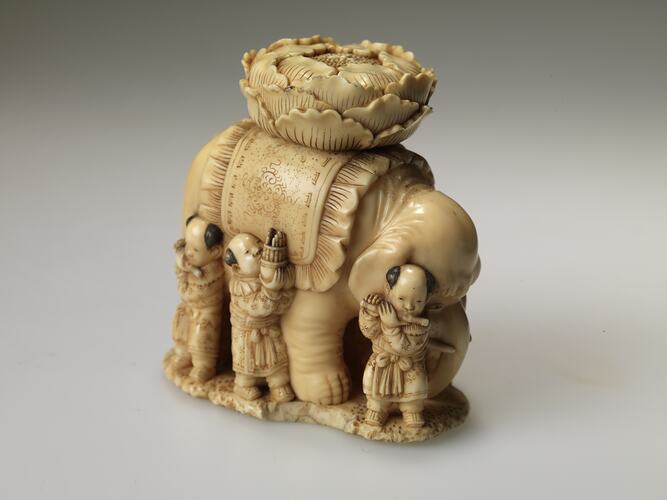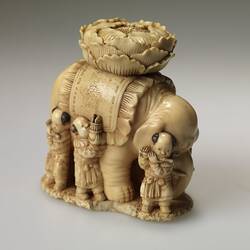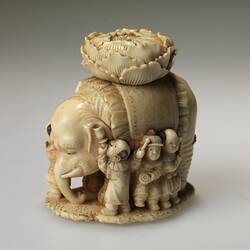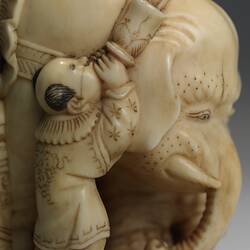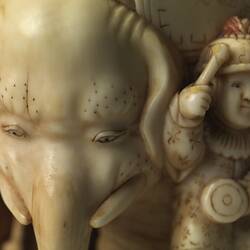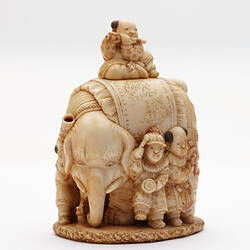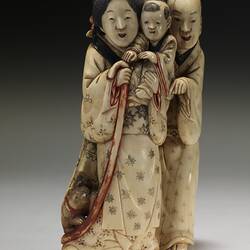Summary
Ivory carving (okimono) of an elephant with musicians (one of a pair). Manufactured in Japan in August 1865 by Koyosai Yushin, whose signature appears on the underside. The inscription underneath indicates that Yushin produced this okimono on request, and it is probably a pair with the related item.
An okimono is an small, carved Japanese decorative object created specifically for display, and typically depicts domestic scenes of farmers, fishermen, and children and occasionally, studies of birds, animals and flowers.
Similar to, but larger than netsuke - which served a practical function as a fastener or toggle - okimono were often presented in the tokonoma, an interior alcove or recess in Japanese homes for the display of pictures or decorative art objects. During the Meiji period (1868-1912), many okimono were made for export to the west.
The musicians have a Chinese appearance, not uncommon in Japanese okimono carvings at this time in which representations of 'Karako', or Chinese, were a popular subject. In the Edo period (1603-1867) in Japan, it was considered a good omen to view foreign animals and their performances, thus it is not unlikely that this okimono was produced as a good luck charm.
Physical Description
One elephant has a lotus flower on its back. It is standing on a base, with three musicians on its left side, two musicians on its right side, and a flautist under its left ear. The other elephant is slightly smaller, has a seated figure on its back and two musicians on its left side, and three musicians on its right.
More Information
-
Collection Names
-
Collecting Areas
-
Acquisition Information
Cultural Gifts Donation from Dr Will Twycross, 23 Jan 2009
-
Acknowledgement
Donated through the Australian Government's Cultural Gifts Program
-
Artist
Koyosai Yushin, Japan, Aug 1865
late Edo Period; Edo Period, 1603-1867; Meiji Period, 1868-1912 -
Place & Date Made
-
Place & Date Exhibited
Royal Exhibition Building (REB), Nicholson Street, Carlton, Greater Melbourne, Victoria, Australia, 1880-1881
-
Collector
Mr John Twycross, Elsternwick, Greater Melbourne, Victoria, Australia, 1881
-
Inscriptions
Both objects signed and dated on underside with columns of kanji. Keiou gan-nen/ Ushi Sei-getsu/ Ou-jyu Ko-yo-sai Yushin English translation: 1865 / the year of the Ox August / Requested Ko-yo-sai Yushin
-
Classification
Royal exhibition building, International exhibitions, Exhibition heritage
-
Category
-
Discipline
-
Type of item
-
Overall Dimensions
77 mm (Width), 55 mm (Depth), 81 mm (Height)
-
Maximum dimensions
74 mm (Length), 58 mm (Width), 77 mm (Height)
Measurement From Conservation.
-
Keywords
Decorative Arts, Exhibitions: Melbourne International, 1880-1881, Ivory, Japanese Art, Japanese Culture, Royal Exhibition Building, Royal Exhibition Building: History of Events, 1879-1899
